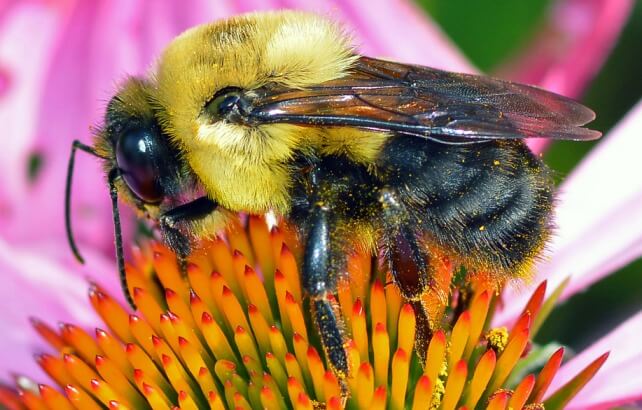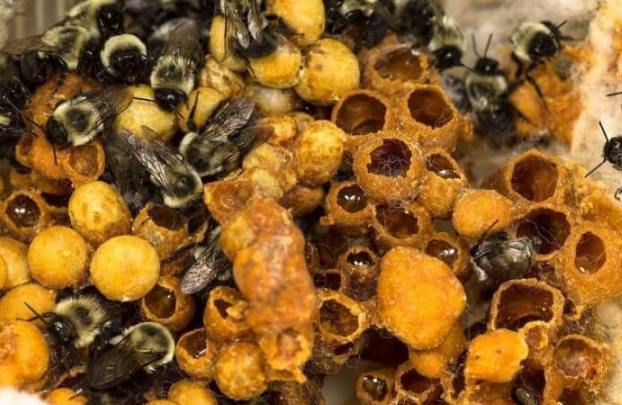Bees make honey. But do all bees make honey? What about the bumblebee that wanders around your terrace garden? Do bumble bees make honey?
Well, honey bees are not the only kind there are. The Apidae (bee) family has about 5700 species.
Bumblebees and honey bees belong to the same family of insects. There are about 250 varieties of bumblebee.
Do bumblebees make honey?
Can I make them a part of my apiary? This is the question that every newly minted beekeeper has. It’s a quite valid query too.
We shall explore the life of bumble bees and their activities.

What is honey?
To answer this question, we have to first understand what is honey?
Honey is a golden syrupy liquid. It is produced by worker honey bees. Bees are quite feudal and have a hierarchy that is remarkably akin to us.
The worker bees extract the pollen from flowers using an elongated tube and store it in a sac. In the sac, the nectar comes into contact with enzymes. These chemicals cause it to break down and make it suitable for long-term storage.
When the bee returns to the hive (remember, we are talking of honey bees) they regurgitate the nectar out.
The rest of the bees now get to work, furiously fanning it with their wings and drying it out. When the water has evaporated, the bees secrete beeswax onto the honey and seal it shut from outside elements.
And why do they go to all this trouble? It is a really ingenious way to store food for the winter months when there are no flowers and thus no nectar to be had.
They not only produce a lot of honey (about 10% of a teaspoonful during their lifetime) but also consume a large part.
Nature is truly incredible in her ways. You can find a whole new paradigm when you observe its ways.
This is what puts honey in our tea and on the toast. Not only humans but wild animals such as bears also break in to taste this drippy sweet treat.
Do bumblebees produce honey?
TL;DR — an empathic NO!
If you are a dogged apiarist who wants to know everything about our winged friend, read on.
Bumblebees also collect pollen, same as honey bees. However, they do not go through the process of changing it to honey in their hive.
The reason? They don’t need to since they never live that long. Most of them die before winter. The queen goes into a long winter sleep.
What do bumblebees do with pollen and nectar?
They consume some of the pollen and nectar they extract. The rest they store but without the fanfare.
The nectar provides them with carbs and the pollen with proteins that they need to survive. Their wings beat hundreds of times every second. No wonder they need a lot of energy for all that frantic activity.
How do bumblebees nest?

Bumblebee honey is not what you usually associate with the word.
They store the nectar and pollen in their hives. To be honest, what they have is not a hive (hanging from a branch) but a nest that is close to the ground.
Old logs that have hollowed out because of weathering are an ideal refuge. They also make rodent holes and old bird nests into their home. They are not very fussy about where they live.
It’s more precise to think of their habitat as nests instead of hives.
Every spring the queen makes honey pots (confusing because they don’t store honey!) by secreting wax from her body.
The worker bees fill these up with the extract they collect. Once they have accumulated enough, the queen lays eggs.
The larvae hatch and provide more bumblebees that bring in more pollen for food, and the colony expands at a swift rate through the spring.
In about a month, a bumblebee hive can be 500 strong.
In contrast, honey bee colonies are vast, with tens of thousands of bees living and working.
Bumblebees—why are they important?
It is wrong to think that simply because they do not produce honey, they are useless.
Bumblebees are important for a different reason. They are far superior when it comes to pollination.
They buzz around longer and their specialized tongues can pollinate flowers that a honey bee cannot.
What is pollination? Basically, it is an important step in plant reproduction.
Pollination is the process that leads to fertilization in plants. Insects transfer pollen, allowing a plant to bear fruits and flowers.
Bumblebees are one of the best at it. While buzzing around for food, they unknowingly pollinate flowers.
Pollination is important, otherwise, there would be no plant products for us to consume—from cereals to sunflower oil.
It would be a bleak world without peanut butter and chocolates. We have bumblebees to thank for it.
Bumblebees are far hardier and work from February till November and can exist in climates that are harsher.
Honey bees are more delicate creatures and would not be able to survive and work with the same intensity.
Few fun facts about bumblebees
Nests & social hierarchy
There are several thousand species of bees, but only bumblebees and honey bees live in a group. You can easily identify a bumblebee because of its size and seemingly Teutonic work ethic. They are roundish and always darting about with no rest. Honey bees are smaller and comparatively dainty.
Hundreds of types
Bumblebees are an entomologist’s delight due to their shape and size.
There are 265 types of bumblebees. It is difficult to tell them apart because many look similar and differ only in more detailed aspects of anatomy. Only someone well-versed can identify some breeds. You can find about 50 types of bumblebees in the continental US.
Fussy about protein intake
Scientists at Penn State University have proven this. They would not consume just any pollen but want the best nutrition. They are able to detect quite easily the quality of pollen with their feelers. No wonder they are so big and strong. Pollen provides protein and strength.
Bumblebee wings beat 200 times every second
That is quite impressive. Especially when you consider they work from sunrise till sunset. Some researchers have estimated that they can fly up to a mile from their hive.
It’s only recently, with cameras that capture thousands of frames every second, has the sequence of their wing beat been deciphered.
They shiver to fight cold weather
Bumblebees living in the Arctic Zone (you can find them in Alaska, Scandinavia, and North Russia) have it tough. They need to warm up before they can take off in the freezing weather. The solution? They shiver a lot and make the flight muscles limber. Rather neat.
There are cuckoo bumblebees too
Just like cuckoo birds get a crow to bring up their offspring, the bumble bees too at times have an imposter in their midst.
Queen cuckoo bumblebees gradually infiltrate the host colony (by mimicking the same chemical signature) and lay their eggs. That’s a neat way to avoid child care and all that hassle.
The largest are terrifying
A South American variant of bumblebee is more than an inch long and is the biggest of the species. The Patagonia bumblebee is a giant among bees. Bee fanatics found it on the southern tip of the continent.
If truth bee told…
They generate a lot of buzz but make no honey. Quite the same as many humans.
But no need to pick on the humble bumblebees. Without them, life on earth would be impossible to sustain.
Read more about bumblebees –